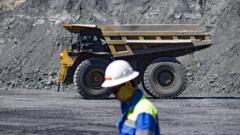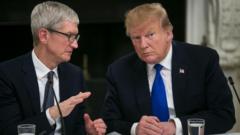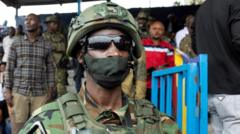This article reveals how the M23 rebel group’s control of tantalum mines in DR Congo intersects with the global smartphone supply chain.
The Hidden Cost of Your Smartphone: Conflict Minerals from DR Congo

The Hidden Cost of Your Smartphone: Conflict Minerals from DR Congo
Exploring the connection between mobile devices and the ongoing war in the Democratic Republic of Congo.
In the heart of your trusty mobile phone lies a vital element known as tantalum, a rare metal extracted from the earth beneath the conflict-ravaged landscape of eastern Democratic Republic of Congo (DRC). This tantalum, crucial for the performance of smartphones and many other electronic devices, could be linked directly to current unrest involving the M23 rebel group, which recently exacerbated tensions with an aggressive assault on Goma, a key trading city.
Tantalum possesses exceptional properties, making it indispensable in modern technology. It is primarily obtained from coltan, a mineral mined extensively in DRC, where as much as 40% of the world's tantalum supply originates. Unfortunately, the eastern region of DRC, rich in resources, is the same battleground for multiple armed groups like the M23, which initially claimed to defend local ethnic communities. Over time, however, these groups have transformed into profit-driven entities controlling mineral extraction operations.
This war-torn area has seen the M23 seize vital towns and resources, including Rubaya, a hub of the coltan industry. Contrary to the dominance of multinational corporations, the mining process here is often marked by an informal landscape where local miners work under perilous conditions in an intricate yet unregulated system. The M23 has imposed a quasi-governmental authority, charging miners hefty fees and ensuring that only their sanctioned traders profit from the rich deposits.
Reports suggest that the M23 could be generating around $800,000 monthly through taxation on coltan mining in Rubaya, purportedly funneling these funds to sustain their armed efforts. The process through which these minerals enter global supply chains has raised concerns, particularly with neighboring Rwanda's role, as many believe it supports the M23 and capitalizes on instability in the DRC.
Multiple international regulations, including the US Dodd-Frank Act and EU legislation, have been designed to cut down the flow of "conflict minerals" into the global economy, but these initiatives struggle with discrepancies in certification processes. Experts note that the dispersed nature of local mining operations and possible corruption impede proper monitoring.
As the M23 continues its influence over the coltan trade, this has spurred questions about how much of the tantalum essential to smartphones around the world is sourced from conflict areas. The Innovative Tin Supply Chain Initiative (Itsci) has faced scrutiny over its effectiveness in promoting ethical sourcing, especially after halting operations in Rubaya post-M23's takeover. Notably, Rwanda’s coltan exports surged significantly in recent times, leading experts to speculate that many minerals entering their market originate from illicit DRC mines.
In light of these developments, the Congolese government has taken a stand by filing legal complaints against major tech companies like Apple for purportedly utilizing conflict minerals. While Apple asserts it has ceased sourcing tantalum from DRC, the opaque nature of the supply chain means that tantalum from conflict zones could still be making its way into various consumer electronics.
The ongoing conflict in eastern DRC continues to intertwine with global tech industries, highlighting a grim reality—our devices, which connect us to the world, may inadvertently tie us to the suffering and instability faced by those in conflict zones. The implications of this connection serve as a haunting reminder of the price of modern conveniences, urging consumers and companies alike to consider the origins of the materials that power our technology.


















